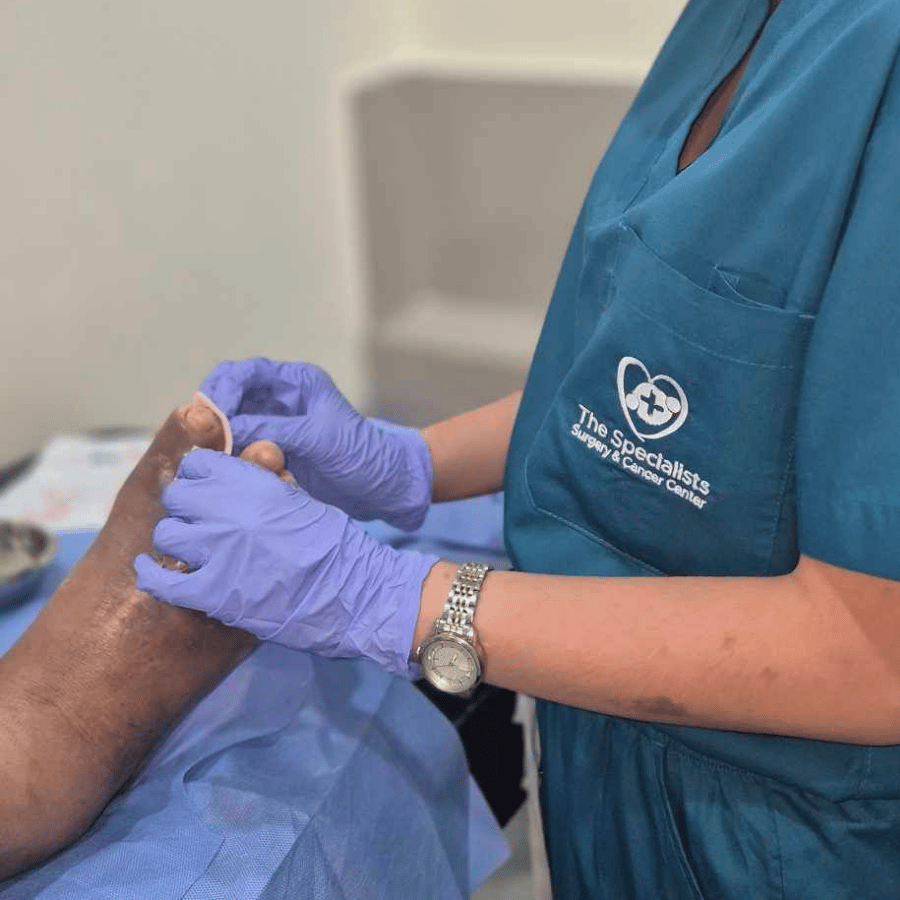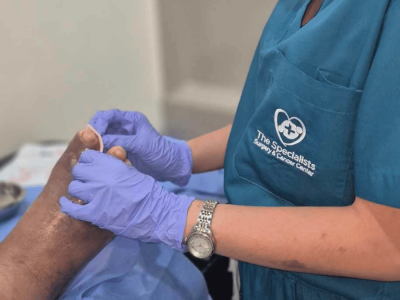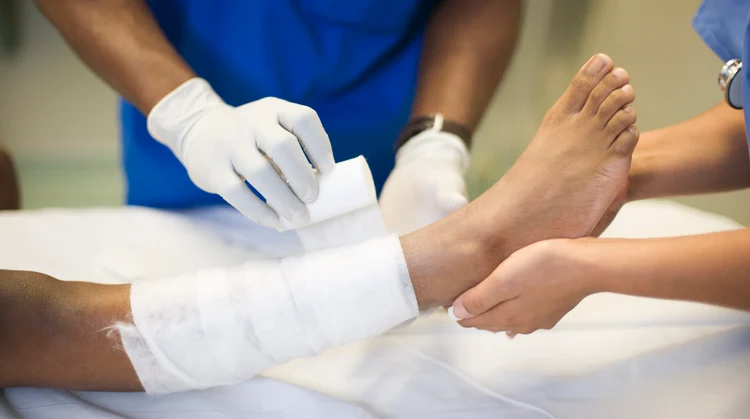Diabetic foot ulcers are one of the most serious complications faced by individuals living with diabetes. These wounds, often stubborn and slow to heal, require specialized care to prevent infections, reduce complications, and promote full recovery. Proper diabetic foot ulcers treatment is essential to protect mobility, enhance quality of life, and avoid severe outcomes such as amputation.
This article explores the causes of diabetic foot ulcers, the importance of timely treatment, advanced management techniques, and practical tips for prevention and long-term foot health.
What Are Diabetic Foot Ulcers?
A diabetic foot ulcer is an open sore or wound that typically forms on the bottom of the foot in people with diabetes. High blood sugar levels can damage nerves and blood vessels, leading to poor circulation and reduced sensation in the feet. This makes patients vulnerable to injuries that can go unnoticed and untreated.
When wounds develop, they heal slowly due to impaired blood flow and weakened immune response, increasing the risk of infection and complications. Common causes of diabetic foot ulcers include pressure from ill-fitting shoes, minor cuts or blisters, and repeated trauma. Understanding these factors is critical to effective diabetic foot ulcers treatment.
Why Proper Treatment of Diabetic Foot Ulcers Matters
Untreated or poorly managed diabetic foot ulcers can lead to serious infections that spread to deeper tissues, including bones. This can cause gangrene, necessitating partial or full amputation of the affected limb. Studies show that diabetic foot ulcers precede about 85% of diabetes-related lower-limb amputations worldwide.
Beyond physical health, diabetic foot ulcers negatively impact mental well-being and independence. Pain, limited mobility, and hospital stays can decrease quality of life. Therefore, prompt and comprehensive diabetic foot ulcers treatment is vital for preventing these adverse outcomes and supporting overall recovery.
Comprehensive Diabetic Foot Ulcer Management Approach
Successful diabetic foot ulcers treatment involves a multidisciplinary and structured plan tailored to the patient’s specific needs. Key components include:
Professional Wound Cleaning: Carefully removing dead tissue and debris helps prevent infection and prepares the wound bed for healing.
Protective Dressings: Using appropriate dressings maintains a moist environment that accelerates healing and protects the ulcer from contaminants.
Infection Control: Regular monitoring and treatment with antibiotics when necessary reduce the risk of bacterial invasion.
Advanced Healing Techniques: These may include debridement (removal of dead tissue), offloading (reducing pressure on the ulcer), and use of specialized wound care products.
Patient Education: Teaching patients about foot hygiene, proper footwear, and signs of infection empowers them to participate actively in their recovery and prevention.
At specialized clinics like the Kalingap Wound Care Clinic in Quezon City, diabetic foot ulcers treatment is delivered by expert teams dedicated to providing personalized care for optimal outcomes.
Advanced Treatment Options for Diabetic Foot Ulcers
Treatment of diabetic foot ulcers has evolved beyond basic wound care. Modern therapies aim to enhance healing speed, reduce infection risks, and improve patient comfort.
Types of Dressings: Hydrocolloid and antimicrobial dressings are commonly used to maintain moisture and protect against pathogens. Some dressings release silver or iodine, which have natural antibacterial properties.
Debridement: Regular removal of dead or infected tissue promotes regeneration of healthy skin and prevents bacterial growth. This can be done surgically or using enzymatic agents.
Offloading Techniques: Using special footwear, casts, or braces reduces pressure on the ulcer site, preventing further tissue damage and allowing healing.
Emerging Therapies: Advanced options such as growth factor applications and hyperbaric oxygen therapy (HBOT) are gaining ground. HBOT, for instance, involves breathing pure oxygen in a pressurized environment, stimulating blood vessel growth and tissue repair.
These advanced diabetic foot ulcers treatment options offer hope for patients facing chronic wounds that do not respond to traditional care.
Infection Control and Prevention in Diabetic Foot Ulcer Treatment
Infections complicate diabetic foot ulcers and pose a significant threat to healing. Early signs of infection include redness, swelling, warmth, pus discharge, and increased pain. It’s crucial to seek immediate medical attention if any of these symptoms appear.
Antibiotic therapy is often required to combat bacterial infections, tailored to the specific pathogens identified through wound cultures. Ongoing wound monitoring ensures that treatment remains effective and adjustments can be made promptly.
Preventing infections involves maintaining strict hygiene, protecting the wound with sterile dressings, and avoiding trauma to the affected foot. Patient adherence to follow-up visits and treatment plans significantly improves outcomes.
Role of Specialized Clinics and Expert Care
Diabetic foot ulcers treatment is most effective when managed by a specialized multidisciplinary team including podiatrists, endocrinologists, wound care nurses, and infectious disease experts. Such teams coordinate care to address not only the wound itself but also underlying diabetes management and vascular health.
Clinics like Kalingap Wound Care Clinic provide a comprehensive approach, combining advanced technologies, expert knowledge, and compassionate care. They offer patients customized treatment plans designed to accelerate healing and restore foot function while minimizing the risk of future ulcers.
Patient Education and Self-Care Tips for Preventing Diabetic Foot Ulcers
Prevention remains the best strategy against diabetic foot ulcers. Patients with diabetes should adopt daily foot care routines, including:
- Regular Foot Inspections: Check for cuts, blisters, redness, or swelling. Use a mirror or ask for help if vision or flexibility is limited.
- Proper Hygiene: Wash feet daily with lukewarm water and mild soap, drying thoroughly—especially between toes.
- Moisturizing: Apply lotion to prevent dry, cracked skin but avoid areas between toes to prevent fungal infections.
- Appropriate Footwear: Wear comfortable, well-fitting shoes with cushioned soles. Avoid walking barefoot, even indoors.
- Prompt Medical Attention: Seek help immediately for any foot injuries, infections, or signs of ulcers.
Educating patients about these preventive measures can reduce the incidence of diabetic foot ulcers and improve long-term foot health.
Takeaway
Effective diabetic foot ulcers treatment requires a comprehensive, patient-centered approach combining advanced wound care techniques, infection control, and preventive education. Early intervention and care from specialized clinics ensure better healing outcomes, prevent serious complications, and preserve mobility.
If you or a loved one is struggling with diabetic foot ulcers, consulting expert wound care providers is essential. Prioritizing foot health today can prevent pain, infection, and disability tomorrow.











